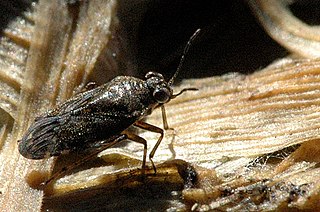
The Heteroptera are a group of about 40,000 species of insects in the order Hemiptera. They are sometimes called "true bugs", though that name more commonly refers to the Hemiptera as a whole. "Typical bugs" might be used as a more unequivocal alternative, since the heteropterans are most consistently and universally termed "bugs" among the Hemiptera. "Heteroptera" is Greek for "different wings": most species have forewings with both membranous and hardened portions ; members of the primitive sub-group Enicocephalomorpha have completely membranous wings.

The Gerridae are a family of insects in the order Hemiptera, commonly known as water striders, water skeeters, water scooters, water bugs, pond skaters, water skippers, water gliders, water skimmers or puddle flies. Consistent with the classification of the Gerridae as true bugs, gerrids have mouthparts evolved for piercing and sucking, and distinguish themselves by having the unusual ability to walk on water, making them pleuston (surface-living) animals. They are anatomically built to transfer their weight to be able to run on top of the water's surface. As a result, one could likely find water striders present in any pond, river, or lake. Over 1,700 species of gerrids have been described, 10% of them being marine.

Veliidae is a family of gregarious predatory insects in the suborder Heteroptera. They are commonly known as riffle bugs, small water striders, or broad-shouldered water striders because the segment immediately behind the head is wider than the rest of the abdomen. Species of the genus Rhagovelia are also referred to as ripple bugs.

Nepomorpha is an infraorder of insects in the "true bug" order (Hemiptera). They belong to the "typical" bugs of the suborder Heteroptera. Due to their aquatic habits, these animals are known as true water bugs. They occur all over the world outside the polar regions, with about 2,000 species altogether. The Nepomorpha can be distinguished from related Heteroptera by their missing or vestigial ocelli. Also, as referred to by the obsolete name Cryptocerata, their antennae are reduced, with weak muscles, and usually carried tucked against the head.

Leptopodomorpha is an infraorder of insects in the order Hemiptera. Leptopodomorpha is an infraorder of the order Heteroptera that contains more than 380 species. These small insects are also called shore bugs, or spiny shore bugs. As their name suggests, shore bugs range from being intertidal, to living near streams and lakes. Four families belong to this infraorder, the largest of which is Saldidae with about 350 species, compared to about 30 in Leptopodidae, and only 5 and 1 in Omaniidae and Aepophilidae respectively. Saldidae are known in particular for their jumping ability.

The Pentatomomorpha comprise an infraorder of insects in the true bug order Hemiptera. It unites such animals as the shield- or stink-bugs, flat bugs (Aradidae), seed bugs, etc. They are closely related to the Cimicomorpha.

Coreoidea is a superfamily of true bugs in the infraorder Pentatomomorpha which includes leaf-footed bugs and allies. There are more than 3,300 described species in Coreoidea.

Velvet water bugs are members of the family Hebridae. They are semiaquatic insects that live among moss or ponds with an abundance of vegetation, in which they prey on small arthropods. Velvet water bugs are the smallest of the Gerromorpha, and have an appearance of tiny veliids. Hebrids sometimes move across water surfaces, but walk or run rather than skate or scull on the surface.

Pleidae, the pygmy backswimmers, is a family of aquatic insects in the order Hemiptera. There are 37 species in three genera, distributed across most of the world, except the polar regions and remote oceanic islands.

Water treaders, the superfamily Mesovelioidea, are insects in the order Hemiptera, the true bugs. They are semiaquatic insects that live in moist and wet habitat and on wet plant matter in several types of aquatic habitat.

Aquarius remigis, known as the common water strider, is a species of aquatic bug. It was formerly known as Gerris remigis, but the subgenus Aquarius was elevated to generic rank in 1990 on the basis of phylogenetic analysis. Aquarius remigis is found throughout North America, but is most prevalent in the mid-west of the United States.

Gerrinae is a subfamily of water strider. This subfamily includes the largest and most best-known group of Gerridae. They are also a phylogenetic subfamily made up of two tribes, and ~14 genera.
Tachygerrini is a tribe of water striders containing 21 species in 2 genera. In addition to the two extant genera, Eurygerris and Tachygerris, Andersen included the extinct genus Eurygerris within the Tachygerrini.

Gerroidea is a superfamily of semiaquatic bugs in the order Hemiptera. There are at least 3 families and more than 2,000 described species in Gerroidea.
Gerris incognitus is a species of water strider in the family Gerridae. It is found in North America.

Mesovelia is a genus of water treaders in the family Mesoveliidae. There are more than 30 described species in Mesovelia.

Mesoveliidae is a family of water treaders in the order Hemiptera. There are about 16 genera and at least 50 described species in Mesoveliidae.

Limnoporus is a genus of water striders in the family Gerridae. There are six extant described species in Limnoporus.

Hermatobates is a genus of wingless marine bugs placed as the sole genus in the family Hermatobatidae that are sometimes known as coral-treaders. They are quite rare and known only from coral reefs in the Indo-Pacific region. During low tide, they move over the water surface not unlike the more familiar water-striders around coral atolls and reefs and stay submerged in reef crevices during high tide.
Paraphrynovelia is a genus of bugs with just two species in southern Africa. Together they are considered by some to form the family Paraphrynoveliidae, although some suggest that they should be treated as members of the Macroveliidae. Unlike other Gerromorpha that are found on the surface of water, Paraphrynovelia brincki specimens were found on wet walls covered in moss or in leaf litter on the forest floor. The family status was suggested in 1978.
















